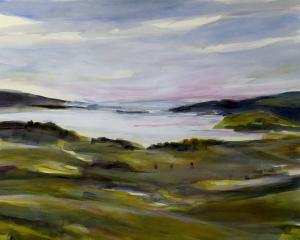
(Olga)
Joanna Margaret Paul’s poem "Blue Fleur" forms the basis for an exhibition at Olga by Natalie Guy and Sandra Bushby.
Guy and Bushby take the poem’s imagery, of half-opened entrances into which colour and air enter a contemplative space, and interpret it in the light of Paul’s life and her meditations on the Catholic faith. They draw connections between Paul’s poetry and her Stations of the Cross panels, painted for St Mary Star of the Sea at Port Chalmers.
The airiness of the poems and the bright glory of the panels find reflection in the minimalist and modernist approach in the current Olga display. Guy presents several angular sculptural forms, free standing and brightly coloured metal assemblages and a smaller, more muted piece in metal and glass. The forms evoke the doorways and airy spaces which are motifs of Paul’s poetry and form central elements of the titular poem.
Bushby’s paintings utilise a soft, almost geometric, abstraction to become meditative works in which form is either almost absent (in the case of Airy and articulate) or becomes a central, entrance-shaped element. The two Freedom works, one a gossamer fog of Marian blue and the other an overlaid pattern of curved window-like forms, are among the stronger works on display.

(Milford Gallery)
Peata Larkin has continued her reinterpretation and updating of the traditional styles of tukutuku and tāniko in an impressive display at Milford Gallery which is paradoxically subtle and bold at the same time.
Rather than her previous use of canvas and paint, in this latest exhibition Larkin uses open lattices of embroidered silk, through which she has injected large drops of acrylic paint in golden yellow and creamy white. The translucence of the silk is beautifully utilised, creating soft surfaces and openings which, when coupled with the lighting of the displays, enables the shadows of the works to become part of their sculptural form. The richness of the colour and the strong geometries of the pattern bring to ming not only traditional Māori weaving styles, but also the comforting warmth of honey, dripping from its combs.
In these works, Larkin has not only extended her own practice and renewed the essence of traditional art, but has also created a series of works in which the strength of the patterning and soft glowing colours have opened up a gateway between Māori cultural forms and western geometrical abstraction. The results are not only an impressive achievement in their own right, but are also strikingly attractive art.

(Fe29 Gallery)
Marian Fountain is a leading New Zealand sculptor, working in bronze. Her exhibition at Fe29 Gallery features a large array of her fine pieces from throughout her career, and though the primary focus is on recent works, there is work from the 1980s through to today. Influences abound, from Blake to Brancusi, all combined and moulded into Fountain’s unique vision and environmental sensibilities.
Fountain’s free-standing patinated sculptures make up much of the exhibition. These largely use organic structures to create works which celebrate life in all its forms. From the surreal plants of the Pousse works through to the Dancing Chromosomes, nature takes centre stage, culminating in the massive trendrilled Green Fingers. Alongside are smaller pieces, such as the lovely, Chinese currency-inspired Heaven and Earth, and the leaf-and-capsule Potent Patent. This latter is a wry comment on medicine patents, traditional remedies, and attempts by companies to gain corporate control of nature.
The exhibition also contains numerous fine wall-plaques, many of which suggest the forms of ancient clay tiles. This is particularly pronounced in works where classical images are invoked (such as Cycle) but is also captured in pieces such as Birth of Venus, a piece which melds Māori and biological elements into its design, as does the intriguing Cell Change.
By James Dignan

!["Flux" featuring Portraits of Geoff Dixon (2021–2025), acrylic on paper [installation view], by...](https://www.odt.co.nz/sites/default/files/styles/odt_landscape_small_related_stories/public/story/2025/07/1_macleod.jpg?itok=ywgJww50)










